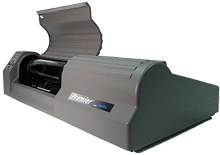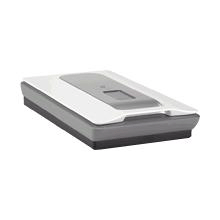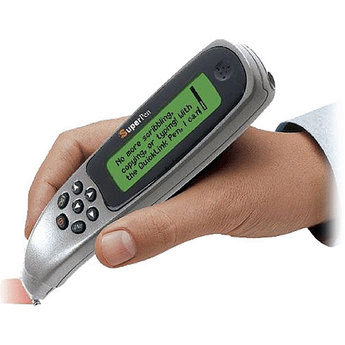Types of Scanners
Drum Scanner: The drum scanner gets its name from the clear acrylic cylinder, the drum, on which the original artwork is mounted for scanning. Depending on size it is possible to mount originals up to 11"x17", but maximum size varies by manufacturer. Drum scanners capture image informati on with photomultiplier tubes (PMT), rather than the charge-coupled device (CCD) arrays found in flatbed scanners and inexpensive film scanners. Reflective and transmissive originals are mounted on an acrylic cylinder, the scanner drum, which rotates at high speed while it passes the object being scanned in front of precision optics that deliver image information to the PMTs. Most modern color drum scanners use 3 matched PMTs, which read red, blue, and green light respectively. Light from the original artwork is split into separate red, blue, and green beams in the optical bench of the scanner. The photomultiplier tube or photo tube is a kind of vacuum tube that can be gas-filled. These tubes are sensitive to different lights including the visible light, near-infrared or the ultraviolet. The drum or acrylic cylinder of the scanner uses PMTs for scanning images. It’s not called a drum scanner for nothing, but because of the large glass drum on which the original artwork is mounted for scanning. Reflective and transmissive originals are mounted on an acrylic cylinder, the scanner drum, which rotates at high speed while it passes the object being scanned in front of precision optics that deliver image information to the PMTs. Most modern color drum scanners use 3 matched PMTs, which read red, blue, and green light respectively. Light from the original artwork is split into separate red, blue, and green beams in the optical bench of the scanner. One of the unique features of drum scanners is the ability to control sample area and aperture size independently. The ability to control aperture and sample size separately is particularly useful for smoothing film grain when scanning black-and white and color negative originals.
on with photomultiplier tubes (PMT), rather than the charge-coupled device (CCD) arrays found in flatbed scanners and inexpensive film scanners. Reflective and transmissive originals are mounted on an acrylic cylinder, the scanner drum, which rotates at high speed while it passes the object being scanned in front of precision optics that deliver image information to the PMTs. Most modern color drum scanners use 3 matched PMTs, which read red, blue, and green light respectively. Light from the original artwork is split into separate red, blue, and green beams in the optical bench of the scanner. The photomultiplier tube or photo tube is a kind of vacuum tube that can be gas-filled. These tubes are sensitive to different lights including the visible light, near-infrared or the ultraviolet. The drum or acrylic cylinder of the scanner uses PMTs for scanning images. It’s not called a drum scanner for nothing, but because of the large glass drum on which the original artwork is mounted for scanning. Reflective and transmissive originals are mounted on an acrylic cylinder, the scanner drum, which rotates at high speed while it passes the object being scanned in front of precision optics that deliver image information to the PMTs. Most modern color drum scanners use 3 matched PMTs, which read red, blue, and green light respectively. Light from the original artwork is split into separate red, blue, and green beams in the optical bench of the scanner. One of the unique features of drum scanners is the ability to control sample area and aperture size independently. The ability to control aperture and sample size separately is particularly useful for smoothing film grain when scanning black-and white and color negative originals.
While drum scanners are capable of scanning both reflective and transmissive artwork, a good-quality flatbed scanner can produce good scans from reflective artwork. As a result, drum scanners are rarely used to scan prints now that high quality inexpensive flatbed scanners are readily available. Film, however, is where drum scanners continue to be the tool of choice for high-end applications. Because film can be wet-mounted to the scanner drum and because of the exceptional sensitivity of the PMTs, drum scanners are capable of capturing very subtle details in film originals.
Only a few companies continue to manufacture drum scanners. While prices of both new and used units have come down over the last decade, they still require a considerable monetary investment when compared to CCD flatbed and film scanners. However, drum scanners remain in demand due to their capacity to produce scans that are superior in resolution, color gradation, and value structure. Also, since drum scanners are capable of resolutions up to 12,000 PPI, their use is generally recommended when a scanned image is going to be enlarged.
Flatbed Scanner: The flatbed scanner, which became affordable later in the 1990’s, reversed the process, with the optical reader placed under a sheet of glass, facing upwards, and items to be scanned laid on the glass. These are able to capture colour images. The quality has improved dramatically over the last decade as prices have fallen.  The flatbed scanner uses CCD (Charged Coupled Device) or CIS (Contact Image Sensor) for scanning. The scanner assembly that uses CCD generally has sensors arranged in three rows. These sensors have different filters – green, blue and red. The scanner has a glass pane and under this plate is a bright light. During the scanning process the pane gets illuminated by the light. The images are placed on the glass pane in a face-down manner. An opaque layer or cover is placed over the image in order to shut out the ambient light.
The flatbed scanner uses CCD (Charged Coupled Device) or CIS (Contact Image Sensor) for scanning. The scanner assembly that uses CCD generally has sensors arranged in three rows. These sensors have different filters – green, blue and red. The scanner has a glass pane and under this plate is a bright light. During the scanning process the pane gets illuminated by the light. The images are placed on the glass pane in a face-down manner. An opaque layer or cover is placed over the image in order to shut out the ambient light.
Even though flatbed scanners are more and more used in various operations, drum scanners continue to be used in high-end applications, such as museum-quality archiving of photographs and print production of high-quality books and magazine advertisements.
Flatbed scanners, also called desktop scanners, are the most versatile and commonly used scanners. They are usually composed of a glass pane(or platen), under which there is a bright light (xenon or cold cathode fluorescent), which illuminates the pane, and a moving optical array. This scanner allows the user to place a full piece of paper, book, magazine, photo or any other object onto the bed of the scanner and has the capability to scan that object.
Images to be scanned are placed face down on the glass, an opaque cover is lowered over it to exclude ambient light, and the sensor array and light source move across the pane, reading the entire area. An image is therefore visible to the detector only because of the light it reflects. Transparent images do not work in this way, and require special accessories that illuminate them from the upper side. Many scanners offer this as an option.
A variant of flatbed scanner is the document scanner.
The scanning or digitization of paper documents for storage makes different requirements of the scanning equipment used than scanning of pictures for reproduction. While documents can be scanned on general-purpose scanners, it is more efficiently performed on dedicated document scanners manufactured by Atiz Innovation, Böwe, Bell & Howell, Canon, Epson, Fujitsu, HP, Kodak and other companies.
A flatbed scanner is usually composed of a glass pane (or platen), under which there is a bright
light (often xenon or cold cathode fluorescent) which illuminates the pane, and a moving optical array in CCD scanning. CCD type scanners typically contain three rows (arrays) of sensors with red, green, and blue filters. CIS scanning consists of a moving set of red, green and blue LEDs strobed for illumination and a connected monochromatic photodiode array for light collection. Images to be scanned are placed face down on the glass, an opaque cover is lowered over it to exclude ambient light, and the sensor array and light source move across the pane, reading the entire area. An image is therefore visible to the detector only because of the light it reflects. Transparent images do not work in this way, and require special accessories that illuminate them from the upper side. Many scanners offer this as an option.
When scanning large quantities of documents, speed and paper-handling is very important, but the resolution of the scan will normally be much lower than for good reproduction of pictures.
Document scanners have document feeders, usually larger than those sometimes found on copiers or all-purpose scanners. Scans are made at high speed, perhaps 20 to 150 pages per minute, often in grayscale, although many scanners support color. Many scanners can scan both sides of double-sided originals (duplex operation). Sophisticated document scanners have firmware or software that cleans up scans of text as they are produced, eliminating accidental marks and sharpening type; this would be unacceptable for photographic work. Files created are compressed as they are made. The resolution used is usually from 150 to 300 dpi, although the hardware may be capable of somewhat higher resolution; this produces images of text good enough to read and for optical character recognition (OCR), without the higher demands on storage space required by higher-resolution images. Document scans are often processed using OCR technology to create editable and searchable files. Most scanners use ISIS or TWAIN device drivers to scan documents into TIFF format so that the scanned pages can be fed into a document management system that will handle the archiving and retrieval of the scanned pages. Lossy JPEG compression, which is very efficient for pictures, is undesirable for text documents.
A specialized form of document scanning is book scanning. Technical difficulties arise from the books usually being bound and sometimes fragile and irreplaceable, but some manufacturers have developed specialized machinery to deal with this. For instance, Atiz DIY scanner uses a V-shaped cradle and a V-shaped transparent platen to handle brittle books. Often special robotic mechanisms are used to automate the page turning and scanning process.
Hand Scanner: In the 1990’s small hand-held scanners became available. The hand-held scanner is available in two different forms – 3D scanner and document scanner. These scanners are moved over the images to be scanned. However, there is a risk of generation of a distorted image by a hand-held scanner. To avoid this, the hand should be steadily dragged over the image. By combining full-color imagery with 3D models, modern hand-held scanners are able to completely reproduce objects electronically. The addition of 3D color printers enables accurate miniaturization of these objects, with applications across many industries and professions.
Hand scanners come in two forms: document and 3D scanners. Hand held document scanners are manual devices that are dragged across the surface of the image to be scanned. Scanning documents in this manner requires a steady hand, as an uneven scanning rate would produce distorted images – a little light on the scanner would indicate if the motion was too fast. They typically have a “start” button, which is held by the user for the duration of the scan; some switches to set the optical resolution; and a roller, which generates a clock pulse for synchronization with the computer.
hand, as an uneven scanning rate would produce distorted images – a little light on the scanner would indicate if the motion was too fast. They typically have a “start” button, which is held by the user for the duration of the scan; some switches to set the optical resolution; and a roller, which generates a clock pulse for synchronization with the computer.
Most hand scanners were monochrome, and produced light from an array of green LEDs to
illuminate the image. A typical hand scanner also had a small window through which the document being scanned could be viewed. They were popular during the early 1990s and usually had a proprietary interface module specific to a particular type of computer, usually an Atari ST or Commodore Amiga.
While popularity for document scanning has waned, use of hand held 3D scanners remains popular
for many applications, including industrial design, reverse engineering, inspection & analysis, digital manufacturing and medical applications. To compensate for the uneven motion of the human hand, most 3D scanning systems rely on the placement of reference markers and typically adhesive reflective tabs that the scanner uses to align elements and mark positions in space.
Handheld scanners have two variations, namely document and 3D scanners. They use the same basic technology as a flatbed scanner, but rely on the user to move them instead of a motorized belt. This type of scanner typically does not provide good image quality. However, it can be useful for quickly capturing text.
Most hand scanners were monochrome, and produced light from an array of green LEDs to illuminate the image. A typical hand scanner also had a small window through which the document being scanned could be viewed. They were popular during the early 1990s.
Handheld 3D scanners are popular for many applications, such as industrial design, reverse engineering, inspection & analysis, digital manufacturing and medical applications.
Interfaces DocuPen RC800 color handheld scanner Enlarge picture The interfaces that scanners use are Parallel, SCSI, USB and FireWire. Parallel is one of the more commonly used interfaces. Parallel scanners will be connected directly into the back of your computer and have an available pass-through port on the back for your computer printer to be connected to.
 Film Scanner DSLR camera and slide scanner: A special piece of equipment that is used to scan films is the film scanner, sometimes called a ‘negative scanner’. Film strips are moved manually across a lens or by using a ‘stepper motor’. The CCD sensors placed inside the scanner scan these films. Slide (positive) or negative film can be scanned in equipment specially manufactured for this purpose. Usually, uncut film strips of up to six frames, or four mounted slides, are inserted in a carrier, which is moved across a lens and CCD sensor inside the scanner. Many models allow an uncut roll to be inserted into the machine where it will scan until the end of the roll. Some models are mainly used for same-size scans.
Film Scanner DSLR camera and slide scanner: A special piece of equipment that is used to scan films is the film scanner, sometimes called a ‘negative scanner’. Film strips are moved manually across a lens or by using a ‘stepper motor’. The CCD sensors placed inside the scanner scan these films. Slide (positive) or negative film can be scanned in equipment specially manufactured for this purpose. Usually, uncut film strips of up to six frames, or four mounted slides, are inserted in a carrier, which is moved across a lens and CCD sensor inside the scanner. Many models allow an uncut roll to be inserted into the machine where it will scan until the end of the roll. Some models are mainly used for same-size scans.
Film scanners work quite simply. Dedicated film scanners are often better than flatbed scanners, regarding the resolution, partly because they don’t need to scan large areas and are dedicated to just sscanning film and negatives. In addition many units will only scan 35mm negatives and slides. The focus of these pages is on these scanners. For more on 35mm negative and slide scanning, click here.
Digital Camera Scanners: Another category of scanner is digital camera scanners, which are based on the concept of reprographic cameras. Due to increasing resolution and new features such as anti-shake, digital cameras have become an attractive alternative to regular scanners. While still having disadvantages compared to traditional scanners (such as distortion, reflections, shadows, low contrast), digital cameras offer advantages such as speed, portability, gentle digitizing of thick documents without damaging the book spine. New scanning technologies are combining 3D scanners with digital cameras to create full-color, photo-realistic 3D models of objects.
“Other”: There are many more types of scanners such as thermal imaging, infrared and ultraviolet. Some even more exotic like those used in the biomedical research area like detection devices for DNA microarrays which are called scanners as well. These scanners are high-resolution systems similar to microscopes. The detection is done via CCD or a photomultiplier tube (PMT).
